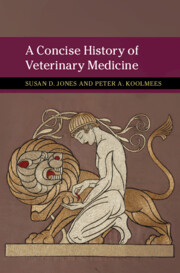Book contents
- A Concise History of Veterinary Medicine
- New Approaches to the History of Science and Medicine
- A Concise History of Veterinary Medicine
- Copyright page
- Contents
- Illustrations
- Tables
- Note on Translations
- Preface
- Introduction
- 1 Animal Healing in Sacred Societies, 1500–1700
- 2 Animal Healing in Trade and Conquest, 1700–1850s
- 3 Formal Education for Animal Healing
- 4 Veterinary Institutions and Animal Plagues, 1800–1900
- 5 Veterinary Medicine in War and Peace, 1900–1960
- 6 Food, Animals, and Veterinary Care in a Changing World, 1960–2000
- 7 Veterinary Medicine and Animal Health, 2000–2020
- Epilogue
- Book part
- Further Reading
- Index
1 - Animal Healing in Sacred Societies, 1500–1700
Published online by Cambridge University Press: 11 August 2022
- A Concise History of Veterinary Medicine
- New Approaches to the History of Science and Medicine
- A Concise History of Veterinary Medicine
- Copyright page
- Contents
- Illustrations
- Tables
- Note on Translations
- Preface
- Introduction
- 1 Animal Healing in Sacred Societies, 1500–1700
- 2 Animal Healing in Trade and Conquest, 1700–1850s
- 3 Formal Education for Animal Healing
- 4 Veterinary Institutions and Animal Plagues, 1800–1900
- 5 Veterinary Medicine in War and Peace, 1900–1960
- 6 Food, Animals, and Veterinary Care in a Changing World, 1960–2000
- 7 Veterinary Medicine and Animal Health, 2000–2020
- Epilogue
- Book part
- Further Reading
- Index
Summary
This chapter highlights traditions of animal healing around the globe, from South American, to Islamic and Ottoman, to Ayurvedic, Chinese, and European. The domestication of elephants, horses, poultry, bovines, and other animals, supplied animal bodies for food, transport, power, and cultural status. Many societies incorporated animals into their sacred traditions and developed elaborate systems of knowledge about animals, including animal healing. Keeping animals close to or inside people’s houses effectively altered the environments of both. People and their domesticated animals shared microorganisms (which also co-evolved with them over time). A major problem with the closeness of human and domesticated animal populations was the spread and evolution of pathogens, forcing healers for both humans and animals to confront the challenges of emergent diseases. Early veterinary activities are analyzed, including professionalization, and linked to the more well-known histories of military animal healers and writings on animal anatomy and medicine by the 1500s.
Keywords
- Type
- Chapter
- Information
- A Concise History of Veterinary Medicine , pp. 13 - 38Publisher: Cambridge University PressPrint publication year: 2022

